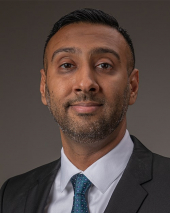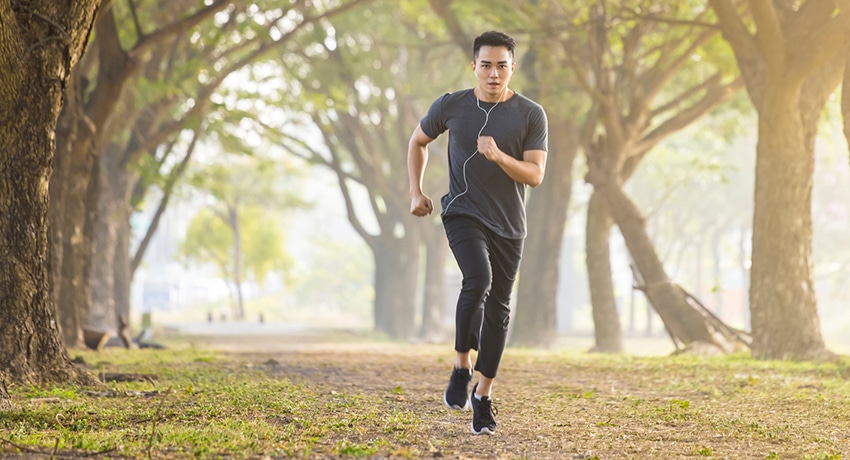
Spring in Houston brings out fresh blooms and bustling sidewalks. Runners, walkers, and joggers are out of hibernation and ready to hit the pavement. Enjoying a successful stride means practicing with purpose. Rehal A. Bhojani, MD, sports medicine physician with UT Physicians, says running properly has two overarching benefits.
“You will maximize your effort and minimize the risk of injury,” he explained.
Running form mechanics
- Always look forward
- Keep posture straight
- Move arms from the shoulder
- Relax hands and shoulders
- Do not bounce while running
“If your core is strong and your mechanics are proper, then you should be doing a proper heel-toe strike to toe push-up, kind of rolling through your foot,” said Bhojani, an assistant professor in the Department of Orthopedic Surgery with McGovern Medical School at UTHealth Houston. “It’s supposed to be natural, it is supposed to be smooth and not flying in the air.”
Pre-run routine
Begin every run or workout with dynamic stretching.
This type of stretching incorporates movement to get your blood flowing, says Bhojani.
“Dynamic stretching movements are the things you see athletes do, where they swing their hips around while jogging and they do kick-ups, and they’re swinging down to touch their toes,” he explained.
Dynamic stretching, he says, will get your blood flow up to help reduce the risk of muscle injury.
Slow and steady
Whether you’re running for exercise or training for an event, proper planning is required to make sure you enjoy the jog without injury.
“Don’t get off the couch and expect to be ready for a half marathon in three to four weeks,” said Bhojani.
He recommends starting slow, taking time to find your pace, and sticking to it before trying to pick up speed.
For novice runners, the average time to train for something like a half marathon is three to four months.
“The key is to give yourself enough time to make sure you increase your mileage every week,” said Bhojani. “You want to reach the 13-mile single run mark one to two weeks before the race.”
Resistance training
An important part of running performance is keeping your muscles strong. Bhojani says most people don’t realize or forget that resistance training must be done two to three times a week.
“It’s like saying I’m going to drive my car perfectly, but I’m not going to get my 5,000-mile oil change,” he said. “You still have to do the little things so that your body can continue to perform.”
The goal of resistance training is to maintain your muscle strength, endurance, and flexibility.
“If you’re new to running, then calisthenics is right for you,” said Bhojani. “That exercise uses only your body weight to train your muscles.”
He also recommends adding light dumbbells and resistance band training.
“Make sure it’s a full body workout including the core, legs, and arms,” he said. “This will help you maintain posture while you run. You’re not looking for any muscle gains.”
Nutrition
Runners, whether new or advanced, have to account for calories that are burned, not just during the runs, but during resistance training as well, says Bhojani. Keeping your body fueled will keep it operating at the highest level.
He recommends eating carbohydrates two hours before a run or workout.
“Afterwards, you want to get some protein and carbohydrates in and in equal fashion,” he said. “A one-to-one ratio of carbs to protein is necessary to account for the calories burned and keep your muscles fed.”
Including iron and vitamin D in your daily diet, he says, is part of the latest research for injury prevention related to bone health.
“When you’re running, you put a lot of stress on your bones,” said Bhojani.
He recommends speaking with a primary care physician to determine how best to incorporate these additional nutrients.
Recovery
Shortly after a run, Bhojani says static stretching is important.
“You’re trying to stretch your muscle out for a longer period in one position,” he said. “Think of the standard stretches like bending over to touch your toes, or sitting down to bend your knees in the butterfly position.”
Bhojani recommends doing each static stretch for 15-20 seconds.
He also stresses that recovery continues well after your running shoes are off and should include restful sleep, proper hygiene, and even massages.
“If you can take care of those things, then your injury risk should continue to drop,” explained Bhojani.
Proper footwear
Wearing the correct shoe for your foot will also reduce your risk of injury.
The first key to a great fit is ensuring the shoe is comfortable. Bhojani also recommends finding a running shoe at a business that offers video running analysis or gait analysis.
“They can put you on a treadmill and watch how your feet land and make recommendations,” he said.
UT Physicians partners with the Memorial Hermann Rockets Sports Medicine Institute to offer a $100 gait analysis at multiple locations.
Once you find shoes you like, do not put more than 250-300 miles on them.
“Think of your shoes like you do your tires. Shoes need to have a good grip, they need to stabilize you, and at some point, you’ll need to replace them,” explained Bhojani.
Never use noise-canceling headphones
For personal safety reasons, Bhojani says, it is important to be able to hear your surroundings at all times. He says listening to music while running is acceptable, but never use noise-canceling headphones.
“Most of the running races won’t let you run with headphones anyway,” he explained.
Reduce injuries for big rewards
Following this advice, while listening to your own body, will teach runners of any level how to run properly, and set them up for triumph on the trail.
“If you are doing all the mechanics that you’re supposed to be doing, the risk of injury should be low because it’s a natural movement that you’ve been doing since childhood,” he said.
Bhojani and the rest of the team with UT Physicians Orthopedic Sports Medicine see patients from children to adults at multiple locations across Greater Houston.



